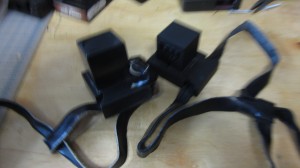It is important for you to know what style of tefillin accords with your personal minhagim (customs). Safeguarding the traditions that have been passed down to you from your family is an important concept in Judaism. If you have a family custom for tefillin, you should follow it. If you do not have a family custom or you are not able to determine what their custom was, please feel free to contact me and I try to help you decide which style of tefillin would be most appropriate for you.
When you place an order for new tefillin I will need to know what style of writing you need and what style of knots to make on the retzuous, (straps). I will also need to know if you wear tefillin on your right or left hand. If you are right handed you will wear tefillin on your left hand, and if you are left handed you will wear tefillin on your right hand. This is because the halacha is that tefillin are worn on the weaker hand.
There are three main styles of writing and four styles of tying the retzuous.
The three styles of writing are Beis Yosef, Ari, and Sfaradi. Chasidim and people of Eastern European descent use ksav Ari. Sfaradim use ksav Sfaradi, and people of Western European descent, and some parts of Poland use ksav Beis Yosef. The Litvish Yeshivos and Shuls use ksav Beis Yosef.

The four styles of tying the retzuous are Ashkenaz, Sfard, Sfaradi, and Chabad. By looking at the following pictures, you will be able to describe what kind of kesherim (knots) that you will need when you place your order. If you are ordering tefillin for a Bar Mitzvah, you should know what type of tefillin the father of the boy wears and set the new tefillin up the same way.




Generally, Ashkenaz retzuous go with ksav Beis Yosef, Sfard retzuous go with ksav Ari, Chabad retzuous go with Ksav Ari ( or sometimes Alter Rebbe Ksav, a type of ksav Ari), and Sfaradi Retzuous go with ksav Sfaradi, sometimes known as Vellish. If you daven in a shul that is different that your family custom, in most cases you should follow your family custom.
